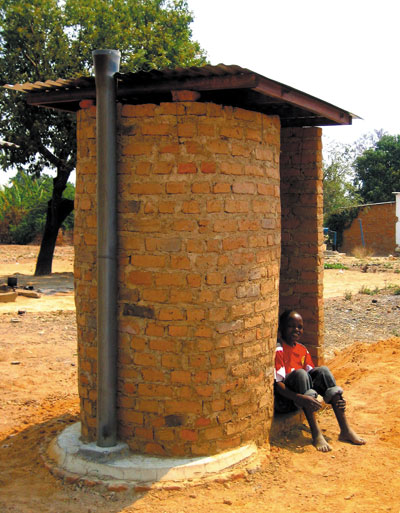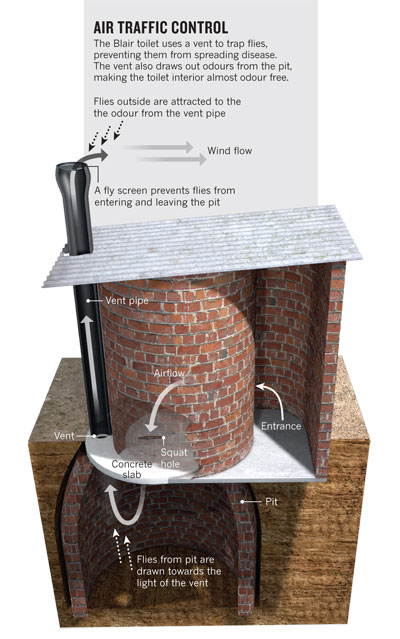- Forum
- categories
- Announcements and miscellaneous
- New publications (books, articles, websites, videos)
- SuSanA Partner and Members featured in Nature : International weekly journal of science
SuSanA Partner and Members featured in Nature : International weekly journal of science
10.9k views
The first is most interesting because we have always built our school urinals in India without roofs. I have never heard a complaint nor been told they are not used when it rains. Perhaps it rains so infrequently in Tamil Nadu it isn't an issue. (However, one should not just accept that a design is OK because it is historic and I will raise the question with my Indian colleagues)
The walls are very high and not easy to see over. They are a good 2 metres high. However, as a small boy I did try and peek into the girls' toilets!!
The cost of the paint is negligible in relation to the overall cost, and we now ask the girls what colours they would like as part of the learning process. It is useful to engage them in this way.
It certainly helps with user appreciation, but we have never experienced vandalism so it is difficult to know whether it helps.
Both of the girls' schools featured have 1,200 (red unit) and 1,500 (lilac unit) pupils attending. The 1,500 girls' unit also has a teacher training facility and so we had to cater for older women as well. I actually stood on a balcony opposite this facility during break time (just out of line of sight I hasten to add) and watched the girls use them. They were all very happy, and I spoke to them afterwards and they told me how much more relaxing and dignifying it was. The central chamber/room in both models is to enable the changing of sanitary towels, which are on sale in the school building, and have a hole through which they are pushed before being burned.
Interesting relating to Madeleine's posts, we had a meeting at the House of Lords in London yesterday and were being told how the next big push was on nutrition. I pointed out that for nutrition to be successful you have to eliminate worms on a long-term, sustainable basis and for that you need ecosan (!) – there was a pause and then a quiet agreement. One day they will learn to join up the dots!
There is a lot happening in India at the moment and we have had many visits by the National and State Govts to our units in Tamil Nadu and now we are being asked to work in Gujarat again in a State Govt project. It is exciting just at the moment!!
Please Log in to join the conversation.
You need to login to replymuench wrote:
With such a dark toilet cubicle, how can you encourage people to keep the area around the drop hole clean? How to encourage young children to use it even though it is scary? How can girls deal with menstrual hygiene issues in near darkness?
Somehow, I can't help getting the feeling that this type of toilet is maybe a bit "old fashioned", suitable for rural areas, but only for rural areas and not e.g. for peri-urban areas where people may strive for something more modern? Or have I misunderstood the whole concept behind them?
Dear Elisabeth,
in my experience, and looking at the construction sketches of the blair type (eg. here ), there is certainly no absolute darkness inside a VIP toilet. Inside a VIP or UDDT toilet, which has a door, it is generally darker. The point is that for the fly sitting on the pile of shit inside the pit, the piece of sky visible in the vent pipe should be lighter than the opening in the toilet slab, so that the fly goes up the vent and is trapped there; a shady inside of the toilet will do it.
As for you feeling of "old-fashioned" vs. "modern" I don't really see difference in principle to other types of toilets. You can make all, VIP, UDDT, pour-flush and other toilets in a flashy modern way or in simple "rural" style. What people actually percieve as modern or as old-fashioned depends much more on their personal point of reference. Eg. I experienced that in northern Vietnam, people think of UDDT as of old-fashionned and rural, because that is how they know them since many many years. In other similarely structures regions, I have seen UDDTs of being much more attractive, because they are "the new thing", compared to their old pit toilets.
Florian
Please Log in to join the conversation.
You need to login to replyOh and about boys looking in girls toilets... I guess it is done for the fun of annoying them and the resulting screams etc. But proving that in a study would require some very creative scientific thinking and probably result in an IgNobel prize
Please Log in to join the conversation.
You need to login to reply- Elisabeth
-
- User is blocked
- Freelance consultant since 2012
Less- Posts: 3372
- Karma: 54
- Likes received: 932
Re: Comments on the Nature article about ecosan examples
After finally having read the above-mentioned article in Nature which features four diverse examples of sustainable sanitation systems, I have a couple of comments to put up for discussion.
First of all it is simply pretty awesome that sanitation finally gets the attention it deserves, also from Nature journalists, and not any kind of sanitation, but actually sustainable sanitation or ecosan (when the focus is on reuse).
I think the intro page is well written and clear.
The four examples cover a wide range of technologies, although I am not sure they are all that representative - e.g. the one from Ralf Otterpohl on Terra Preta sanitation is far less developed compared to the Blair VIP latrines from Peter Morgan, but maybe this is done on purpose. (journalists just love the whole Terra Preta thing because from their perspective, ancient Indio knowledge from the Amazon is coupled with modern technology and that is something the readers like)
I know the Ventilated Improved Pit Latrines (VIPs) that Peter Morgan developed in Zimbabwe has done wonders for rural sanitation and surely saved countless lives. However, I do have one concern: they are designed with the aim to minimise flies leaving alive and for that reason they have to be quite dark inside. Their design was not primarily for maximising user comfort...
With such a dark toilet cubicle, how can you encourage people to keep the area around the drop hole clean? How to encourage young children to use it even though it is scary? How can girls deal with menstrual hygiene issues in near darkness?
I include here two photos from the article:
Somehow, I can't help getting the feeling that this type of toilet is maybe a bit "old fashioned", suitable for rural areas, but only for rural areas and not e.g. for peri-urban areas where people may strive for something more modern? Or have I misunderstood the whole concept behind them?
Quite a contrast are these school toilets of Whereever the Need in India which are also featured in the article. See here:
Looks extremely bright, colourful and modern... Although here I am wondering: are they really being built without a roof or was the photo taken before construction was finished? Without a roof they cannot be used during rainy weather, also boys could look over the walls from the outside and disturb the girl's privacy? (is it actually a myth that boys would be attracted to seeing girls in the toilet or a proven fact? I am trying to think back to my childhood and I can't remember such an incident).
Also the question pops up, how much higher is the construction cost due to the additional paint and other beautiful design features? Or does that pay off because there is less vandalism and more user appreciation of these toilets?
David Crosweller from WTN can you please clarify this issue of the roof and costs, and perhaps tell us a bit more about these toilets which are featured in this Nature article?
Regards,
Elisabeth
Freelance consultant on environmental and climate projects
Attachments:
-
 BVIP.jpg
(Filesize: 70KB)
BVIP.jpg
(Filesize: 70KB)
-
 BVIPschematic.jpg
(Filesize: 63KB)
BVIPschematic.jpg
(Filesize: 63KB)
-
 WTN.jpg
(Filesize: 24KB)
WTN.jpg
(Filesize: 24KB)
Please Log in to join the conversation.
You need to login to replyRe: Productive sanitation mentioned as a practical and successful innovation for transformation of the food System
This is a fantastic follow-up of my previous posting .
The SIANI Session on Productive Sanitation successfully left important marks behind at CGIARs Agriculture and Rural Development Day
In below the cite from the full text at the ARDD webpage ccafs.cgiar.org/blog/small-wins-small-fa..._12&utm_medium=email
“ Indeed Agriculture and Rural Development Day brought together over 600 key people working in agriculture and food security, to share practical and successful innovations for transforming the food system, including• New livestock feeding practices that can improve livelihoods and reduce greenhouse gas emissions
• How to measure progress as a mosaic of solutions are applied in agricultural landscapes.
• Local solutions for nutrient management in Niger that improve crop quantity, minimize resource use and reduce pollution, while enhancing local sanitation.”
This is an important landmark to continue the research on nutrient reuse and how it can contribute to climate smart agriculture and benefit of the poorest of the poor in rural areas and the small holder farmers providing more food of good quality and sanitation .
A luta continua
madeleine
Program Director SIANI
Senior Project Manager at SEI
Tel +46 (0)8 6747652
Fax + 46 (0)8 6747020
Cell + 46 737078576
SKYPE mfogde71811
Kräftriket 2B
SE-10691 Stockholm
www.siani.se
www.ecosanres.org
www.sei-international.org
Please Log in to join the conversation.
You need to login to replyRe: ProSan in Rio and SuSanA Partner and Members featured in Nature : International weekly journal of science
It is great that Nature has featured Sustainable Sanitation Design . Quote from the article " So a toilet can be transformative. A clean environment means better health — and that, in turn, is a springboard to development. As governments debate the finer points of global development challenges at Rio+20 next week, they might find it worth asking why sanitation falls to the bottom of most policy agendas"
From SIANI ,the Swedish International Agriculture Initiative we brought in Productive Sanitation to the Climate Change and Food Security Agendain Rio on the AGriculture and Rural Development Day 18th of June. The idea was to show the added value and the innovation of recycling nutrients from urine in rural (IFADS and Ministry of Agriculture project in NIger) and urban agricultures (the program on alotmentgardening and vegetable farms as well as school food/ sanitation programs in the Philipinnes).
The idea was to present the important nexus between water, agriculture and nutrients
This was a very important first step to anchor Productive Sanitation within the framing of Climate smart agriculture. You will be able to find more information about the event on www.siani.se/ARDD-LE9
Allt the best
madeleine
Program Director SIANI
Senior Project Manager at SEI
Tel +46 (0)8 6747652
Fax + 46 (0)8 6747020
Cell + 46 737078576
SKYPE mfogde71811
Kräftriket 2B
SE-10691 Stockholm
www.siani.se
www.ecosanres.org
www.sei-international.org
Please Log in to join the conversation.
You need to login to reply- secretariat
-
 Topic Author
Topic Author- Moderator
- SuSanA secretariat currently allocates 2 full time person equivalents of time from members of GIZ Sustainable Sanitation Team: Arne Panesar, Alexandra Dubois, Maren Heuvels, Teresa Häberlein, Daphne Manolakos and Bettina-Sophie Heinz.
SuSanA Partner and Members featured in Nature : International weekly journal of science
The Nature journal article "Ecodesign: The bottom line" available here: www.nature.com/nature/journal/v486/n7402/full/486186a.html
Featured
The SuSanA partner WTN and their country director of India, Shunmuga Paramasivan with the article on "Creating social inclusivity for girls and women".
And the following SuSanA members:
Peter Morgan with "Inspired by ant turrets and the flight paths of flies".
Ralf Otterpohl with "Boosting compost with biochar and bacteria".
It makes for good reading.
Congratulations to WTN, Shunmuga, Peter and Ralf.
Rgds
Trevor
Located at Deutsche Gesellschaft für Internationale Zusammenarbeit (GIZ) GmbH, Bonn, Germany
Follow us on facebook: www.facebook.com/susana.org, linkedin: www.linkedin.com/company/sustainable-sanitation-alliance-susana.
Please Log in to join the conversation.
You need to login to reply- Forum
- categories
- Announcements and miscellaneous
- New publications (books, articles, websites, videos)
- SuSanA Partner and Members featured in Nature : International weekly journal of science








